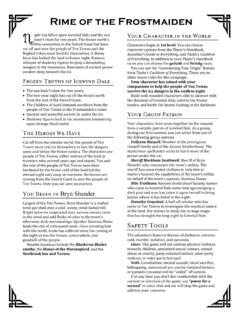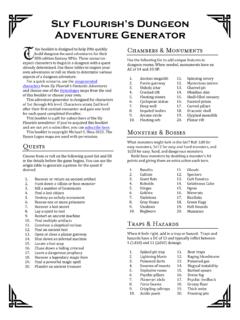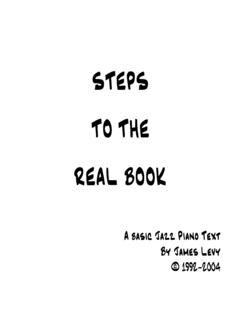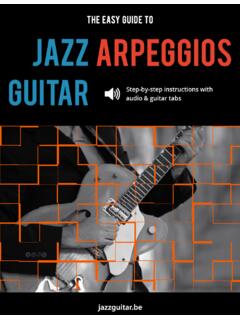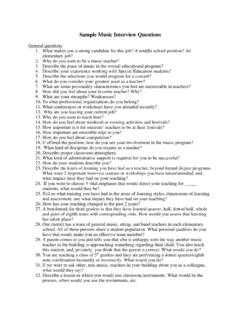Transcription of SLY FLOURISH’S THE LAZY DM’S COMPANION
1 MICHAEL E. SHEAMICHAEL E. SHEAGUIDELINES AND INSPIRATION TO HELP YOU RUN AWESOME FIFTH EDITION FANTASY ROLEPLAYING GAMESTHE LAZYTHE LAZY DM S COMPANIONDM S COMPANIONSLY FLOURISH SSLY FLOURISH STHE LAZYTHE LAZY DM S COMPANIONDM S COMPANIONSLY FLOURISH SSLY FLOURISH Sby Michael E. SheaDesign by Michael E. SheaEditing by Scott Fitzgerald GrayCover art by Jack KaiserInterior Art by Matt MorrowCartography by Daniel WalthallPage design by Marc RadleLayout by Scott Fitzgerald GrayVisit for DM guides and articlesVisit for daily DM tipsCopyright 2021 by Michael E. Shea22 INTRODUCTIONINTRODUCTIONThis book is the third in the Lazy DM s series, alongside Return of the Lazy DM and The Lazy DM s Workbook.
2 As with each of those books, you don t need to read the entire series to find value in this book. Each title stands alone, but also works together with the others to help you run great fantasy RPGs. Return of the Lazy DM offers an eight-step framework for preparing for your game, along with deeper dives into setting up, running, and thinking about your game. The Lazy DM s Workbook sits beside you at your table when you re running your game, offering references, random tables, and maps to help you improvise as things take unexpected turns. The Lazy DM s COMPANION is designed to work with you while you re preparing your game, offering guidelines and inspiration to make running games easier, and to help you build fantastic adventures and campaigns.
3 Over the past seven years of running the fifth edition of the world s most popular fantasy roleplaying game, we ve all learned new tips and tricks to make things run better. We ve looked at the bumps and sharp corners of this system and have learned how to smooth them out. This book contains more such guidelines, all designed to make it easier to run our games and focus on the parts that bring the most fun to the table. Although this book was written with fifth edition fantasy in mind, much of what s here can be used with any fantasy RPG. About half the book contains guidelines to help you prepare and run 5e fantasy games, with those guidelines able to be used alone or in conjunction with other parts of the book as you see fit.
4 You re free to use what works for you, to skip what doesn t, and to modify any of the book s suggestions and advice to suit your game including modifying it for games other than 5e fantasy. The other half of the book contains adventure generators sets of random tables built around a particular adventure theme, from protecting a village to determining what horrors might be imprisoned in an ancient keep. There s also a core adventure generator with tables to suit many different adventure types. The random tables in the book have been grouped around these adventure types, so you typically won t need to flip around to access all the tables you need to build a particular type of adventure.
5 We spent a lot of effort making sure that the tables hit the right resolution specific enough to give you clear ideas you can use, but general enough that you don t get overtaken by minutiae. This book also contains a number of location maps. While the maps in The Lazy DM s Workbook focused on specific locations, the maps in this book are more general purpose. Each has been designed to serve as the basis for multiple locations, using a mixture of natural and constructed environments. Each has enough details to fill things out, but enough details left blank that you can use them in multiple RANDOM TABLESThis book makes heavy use of random tables, in the hope of inspiring all of us as DMs to let our minds travel in directions we never would have considered on our own.
6 These random tables aren t intended to build entire adventures with just a few dice rolls. Rather, they re intended to inspire you to come up with your own adventure ideas as you and the dice work together to create something new and unique. When you re sitting down to plan an adventure, go through the generators in this book and see if any of them includes a theme that excites you. Then roll on the tables in that generator and see what comes up. The results might make no sense to you initially. But spend some time with them, and see if you can make sense of them as the story forms in your mind.
7 If they really don t work, just reroll and try again. Random tables alone aren t enough to build a fun game, but a creative mind fueled by randomness can come up with truly unique and inspiring FOR STORY-FOCUSED GAMESAll the guidelines in this book serve one ultimate purpose to make it easier for you to run your games while staying focused on the evolving story taking place at your table. This book is built from the philosophy that the stories we share with friends and family matter more than the mechanics of the game. The mechanics serve the story, not the other way around. Likewise, the book is built around the idea that as DMs, we don t write the story ahead of time.
8 Rather, we set the stage for the story that we and the players create at the table together. Every part of this book is intended to make it easier to share that story. As such, the book abstracts the mechanics as much as possible to keep a focus on high-action fantasy roleplaying. As you would expect from any Lazy DM book, The Lazy DM s COMPANION aims you towards the easy path whenever possible, sometimes simplifying the fine details that other DMs embrace. This process might push too far for you in some areas. That s fine. Just use the guidelines that help you share the story you want to share in the way you want to share following tools can help you improvise during your games.
9 Keep a copy of this section handy, paste notes in your favorite DM s book, or memorize the key mechanics presented here to help you react to unexpected events and unforeseen changes in the CHECKSFor any given task or challenge, ask yourself how hard it is to accomplish. Then assign a DC from 10 (easy) to 20 (very hard). If a task is trivial, don t bother asking for a roll. Rather, the characters automatically succeed. Likewise, reserve DCs above 20 for superhuman DAMAGED ecide on a challenge rating (CR) for the source of the damage, from CR 1 (low challenge) to CR 20 (very high challenge). Then roll a number of damage dice of a particular kind, as follows: Single-Target Damage: CR 5 (d10) Multiple-Target Damage: CR 3 (d6) This challenge rating can be thought of as roughly equivalent to the average level of a group of characters.
10 However, don t automatically choose a challenge rating based on the level of the characters. Rather, the level of the challenge might be higher or lower than the characters, depending on the STATISTICSW henever you need to improvise the Armor Class and saving throws for a creature, or the saving throw DCs for effects created by the creature, use the following guidelines based on the creature s challenge rating: AC = 10 + 1/2 CR DC = 10 + 1/2 CR Attack Bonus = 2 + 1/2 CR Saving Throw with Proficiency = 2 + 1/2 CR Hit Points = 20 CR You can use the same process to improvise similar statistics for traps and other objects that deal damage and can be attacked to destroy them.
